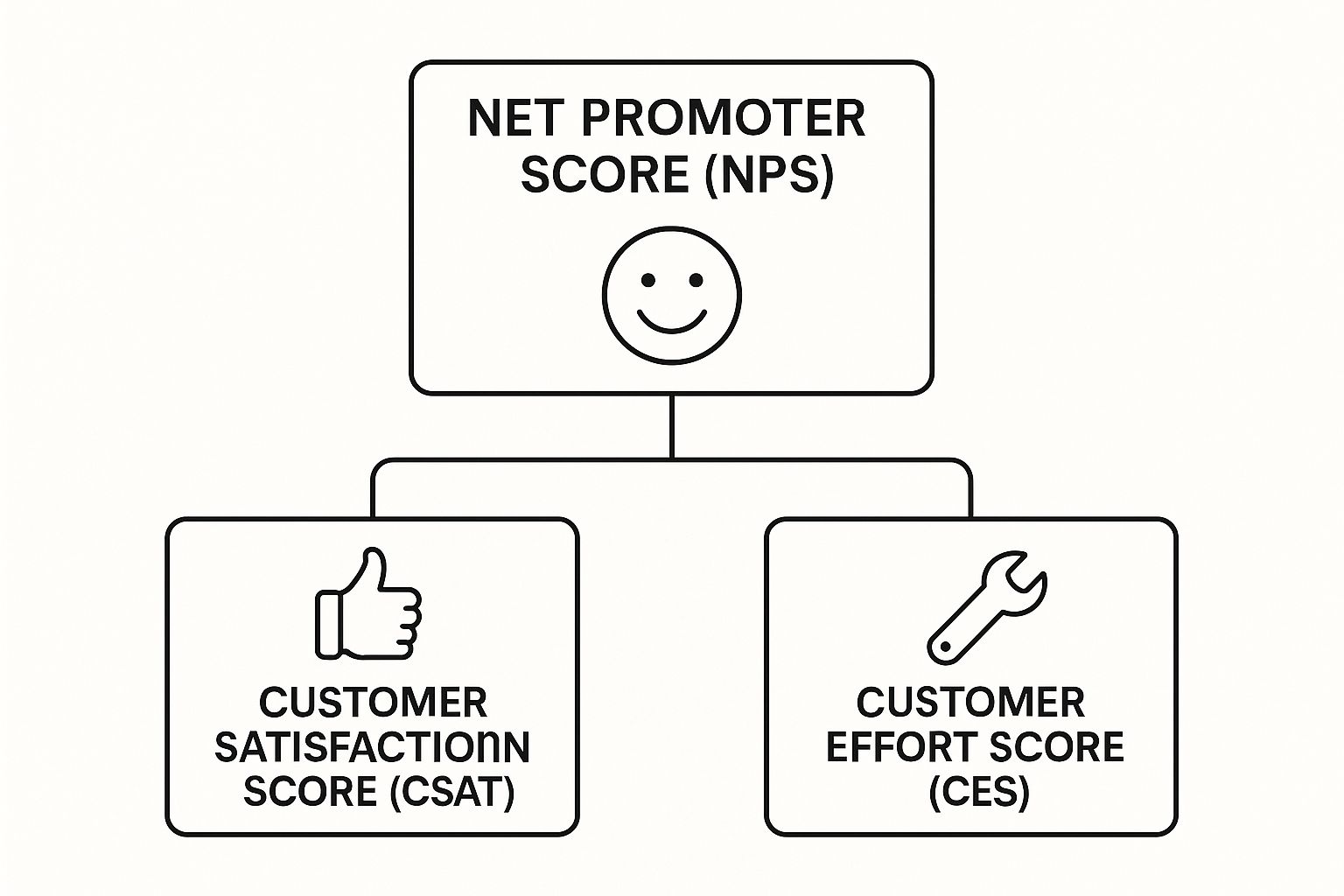In a market flooded with choices, a great product alone no longer guarantees a win. This is where customer experience measurement becomes essential. It’s the strategic practice of tracking, analyzing, and ultimately improving how customers feel about every interaction with your brand. It moves you from guessing what people want to knowing what truly matters to them.
Why Customer Experience Measurement Matters Now

Imagine your business as a ship on a vast, unpredictable ocean. The currents and winds are your customers' ever-changing expectations. Without a reliable navigation system, you're merely drifting and hoping for the best.
Customer experience measurement is that navigation system. It provides the hard data needed to steer your company with intention, ensuring you not only meet but exceed those expectations.
Ignoring what your customers are telling you is like sailing blindfolded. Today, the consequences are swift and severe. A staggering 52% of customers will switch to a competitor after just one bad experience. That single interaction can mean the difference between loyalty and loss.
In an age of instant gratification, customers also demand speed. A full 90% believe an immediate response is crucial for good service. You can explore these customer experience statistics to better understand the modern consumer.
Connecting CX to Business Outcomes
This isn't just about collecting feel-good feedback. When you get serious about measuring customer experience, you create a direct line to tangible business results. It’s a powerful driver for growth.
The connection manifests in several crucial ways:
- Increased Revenue: Happy customers don't just stick around; they buy more. A consistently positive experience makes them more likely to make repeat purchases, increasing their lifetime value.
- Enhanced Customer Retention: It costs significantly more to acquire a new customer than to keep an existing one. By identifying and fixing friction points in their journey, you give them every reason to stay loyal.
- Stronger Brand Reputation: Word-of-mouth is more powerful than ever. Customers who love their experience with you become your best marketers, sharing positive stories and attracting new business organically.
By transforming abstract feelings into concrete data, customer experience measurement allows you to make informed, strategic decisions. It turns customer feedback from a passive suggestion box into an active, dynamic tool for growth and resilience.
A Non-Negotiable Strategy
Ultimately, consistently measuring the customer experience is no longer a "nice-to-have." It's a core component of any intelligent business strategy. It provides the clarity to allocate resources where they will have the most impact, align your entire team around a common goal, and build a truly customer-first culture.
Companies that weave this practice into their daily operations are simply better prepared to adapt and innovate. This proactive approach doesn't just help you survive; it positions you to lead your market by building a loyal customer base that fuels sustainable growth.
Decoding the Core Metrics of CX
To truly get a handle on customer experience measurement, you must go beyond simply acknowledging that feedback is important. The real value emerges when you understand what to measure and why. Think of CX metrics as a diagnostic toolkit; each tool is designed to assess a specific aspect of health, providing a clearer, more complete picture of what's really happening.
This is more critical than ever. Recent findings show that CX quality is slipping worldwide. In North America, a staggering 25% of brands saw their CX scores drop for the second consecutive year, while a mere 7% actually improved. This growing gap between customer expectations and business delivery makes a robust measurement strategy a matter of survival.
So, how do you navigate this? Smart businesses rely on a core set of metrics to cut through the noise. While there are dozens you could track, three stand out for their clarity and direct business impact.

As you can see, loyalty (NPS) is the ultimate prize, but it’s directly supported by immediate satisfaction (CSAT) and the ease of experience you provide (CES).
Net Promoter Score (NPS)
If you're looking for one number closely tied to long-term loyalty and growth, it's the Net Promoter Score (NPS). This metric gets to the heart of the customer relationship by measuring their willingness to recommend your brand to others.
It all boils down to a single, powerful question:
“On a scale of 0 to 10, how likely are you to recommend our company to a friend or colleague?”
Based on their answers, customers fall into one of three categories:
- Promoters (9-10): These are your brand evangelists. They're loyal, enthusiastic, and actively drive new business your way through word-of-mouth.
- Passives (7-8): They're satisfied but not thrilled. They are content but not committed, making them vulnerable to competitor offers.
- Detractors (0-6): These are your unhappy customers. Not only are they at risk of leaving, but they can also damage your reputation with negative feedback.
Your final NPS score is calculated by subtracting the percentage of Detractors from the percentage of Promoters. It's a tough but honest look at your brand's health.
Customer Satisfaction (CSAT)
While NPS provides a big-picture view of loyalty, Customer Satisfaction (CSAT) is about the here and now. It measures short-term happiness with a specific interaction, like a purchase or a support call. It’s a snapshot of a single moment in the customer journey.
You'll typically see CSAT surveys appear right after a key touchpoint. The question is direct and simple:
“How satisfied were you with your recent purchase?”
Responses are usually on a 1-5 scale, from "Very Unsatisfied" to "Very Satisfied," and your score is the percentage of customers who chose "Satisfied" or "Very Satisfied." Its power lies in its immediacy—it helps teams spot and fix friction points before they escalate.
Customer Effort Score (CES)
Finally, the Customer Effort Score (CES) asks a fundamentally different but crucial question: "How easy was it to get what you needed?" This metric measures the amount of friction in an experience, because making things effortless is a direct path to loyalty.
High effort is a massive driver of disloyalty. Nothing kills goodwill faster than having to jump through hoops to get an answer or fix a problem. Building intuitive user paths is foundational, and you can learn more by exploring the principles of good website design.
The CES question is often framed as a simple statement for the customer to rate:
“The company made it easy for me to handle my issue.”
When you lower the effort, you show customers you respect their time. This can turn a potentially frustrating service interaction into a positive experience that builds loyalty.
Key CX Metrics at a Glance
Each of these metrics provides a unique lens through which to view your customer experience. While they can be used alone, their true power is unlocked when you use them together to get a holistic view.
Here's a quick comparison to help you see how they fit together:
MetricWhat It MeasuresExample QuestionPrimary Use CaseNet Promoter Score (NPS)Overall brand loyalty and willingness to recommend."How likely are you to recommend us to a friend?"Predicting long-term growth and identifying brand advocates.Customer Satisfaction (CSAT)Short-term happiness with a specific interaction or touchpoint."How satisfied were you with your support call today?"Diagnosing and fixing issues at specific points in the customer journey.Customer Effort Score (CES)The ease or difficulty of a customer's interaction."How easy was it to resolve your issue?"Reducing customer friction and improving process efficiency.
By combining the big-picture loyalty view from NPS, the transactional feedback from CSAT, and the process insights from CES, you can stop guessing and start making targeted improvements that truly matter to your customers.
Combining Data for a Complete Customer Picture

Metrics like NPS, CSAT, and CES are fantastic for getting a pulse on your customer experience, but they only tell you half the story. The numbers tell you what is happening. For instance, a sudden dive in your CSAT score is an alarm bell that something has gone wrong.
But those scores rarely tell you why. To get to the root cause, you have to look beyond the numbers and listen to what your customers are actually saying. This is where the real power of customer experience measurement lies: in weaving together different kinds of data.
Think of it this way: your quantitative data is a map of the customer journey, pinpointing the exact spots where they run into trouble. Your qualitative data is their travel diary, filled with the rich details of their trip. You need both to truly understand their experience and improve the road ahead.
Understanding the Two Sides of Data
Getting a full, 360-degree view of your customer experience means blending two types of information. Each one gives you a unique perspective, and when you combine them, you unlock actionable insights.
- Quantitative Data (The "What"): This is anything you can count or measure. It’s the hard data behind customer behavior—your CSAT scores, churn rates, page views, and cart abandonment rates. It’s objective, straightforward, and ideal for spotting trends across your entire customer base.
- Qualitative Data (The "Why"): This is the descriptive context that explains the emotions and reasons behind the numbers. You’ll find it in open-ended survey answers, customer interviews, support chat logs, and online reviews. While subjective, it's packed with the nuance needed to understand your customers' real motivations.
On their own, both types of data have blind spots. A high cart abandonment rate (quantitative) tells you there's a problem, but it’s the customer comment, "The shipping costs were a surprise at the end!" (qualitative) that tells you exactly what to fix.
Methods for Gathering Qualitative Insights
While most quantitative metric tracking can be automated, gathering good qualitative feedback requires a more hands-on approach. The goal is to open channels where customers feel comfortable sharing their honest thoughts in their own words.
Here are a few proven ways to collect these crucial stories:
- Open-Ended Survey Questions: After a standard NPS or CSAT rating, simply add a follow-up question: “Could you tell us a bit more about why you chose that score?” You'd be amazed at the valuable information you can mine from that one addition.
- Customer Interviews: Schedule short, one-on-one calls with a handful of customers. This is your chance to go deep, ask follow-up questions, and get to the emotional core of what drives their loyalty or frustration.
- Usability Testing: There’s nothing more powerful than watching a real person try to use your product or website. Observing their struggles and hearing them think aloud provides undeniable proof of friction points that analytics reports will never show you.
- Social Listening and Review Monitoring: Keep a close watch on what people are saying about you on social media, industry forums, and review sites like G2 or Capterra. This unsolicited feedback is often brutally honest and incredibly valuable.
True customer understanding clicks into place when you connect a data point to a human story. A -10 NPS score is just a number until you read the feedback from a customer who felt completely ignored by your support team. That connection is what sparks meaningful change.
Weaving Data Streams into a Single Narrative
Once you’re collecting both quantitative and qualitative data, the final step is to bring them together. This is how you turn a pile of disconnected facts into a clear story your team can use to make smart decisions.
Let's say a SaaS company sees a 15% increase in churn (quantitative) among new users in their first 30 days. That’s a worrying number. Then, they dig into their qualitative feedback and find a common thread in support tickets and exit surveys: "I couldn't figure out how to set up my first project."
Suddenly, the complete picture emerges. The problem isn’t the price or a bug—it’s a confusing onboarding experience. With this clear diagnosis, the company knows exactly where to invest its resources. They can build an interactive setup wizard or create a new tutorial video to attack the root cause of the churn.
This integrated approach to customer experience measurement shifts your entire strategy from reactive to proactive. You stop playing whack-a-mole with problems and start building a fundamentally better customer journey based on a genuine understanding of what your customers actually need.
Choosing Your Customer Experience Toolkit
Once you have a handle on the right metrics, the next step is picking the right tools for your customer experience measurement program. The market is flooded with options, and it’s easy to get overwhelmed. But building a great CX tech stack isn’t about buying the most expensive, feature-packed platform; it’s about choosing tools that solve your specific problems.
Think of it like putting together a workshop. You wouldn't buy a massive industrial machine if all you need is a good hammer and a reliable saw. Your CX toolkit should be the same—perfectly suited to your company’s size, goals, and budget. The real goal is to assemble a set of tools that work in harmony to capture feedback, analyze customer behavior, and get those insights to the people who can act on them.
All-In-One CX Management Platforms
For businesses serious about putting customer experience at the heart of their strategy, all-in-one platforms are the mission control center. Systems like Qualtrics or Medallia are designed to bring multiple CX functions together under one roof.
These platforms do much more than just send surveys. They integrate NPS, CSAT, and CES tracking with sophisticated analytics, text and sentiment analysis, and even predictive modeling. This allows you to connect feedback from various sources—email, web, mobile apps, and call center transcripts—to create one cohesive picture of the customer journey.
The biggest advantage is having all your data in one place. Instead of your team wrestling with different spreadsheets and siloed reports, everyone gets a single source of truth. This makes it much easier to spot cross-channel trends and diagnose complex issues that a standalone tool would likely miss.
Essential Supporting Tools
While all-in-one platforms are incredibly powerful, they aren't for everyone. You can build a highly effective CX program by combining a few specialized, best-in-class tools.
- Survey Platforms: Tools like SurveyMonkey and Typeform are the workhorses for collecting direct feedback. They make it incredibly simple to design and send NPS, CSAT, and CES surveys or more in-depth questionnaires. They are fantastic for getting quick, targeted feedback on specific interactions.
- Web and Product Analytics: To understand what customers do (not just what they say), you need analytics. Google Analytics is the go-to for tracking website behavior like page views, session duration, and bounce rates. For a deeper look inside your app, product analytics tools like Mixpanel or Amplitude show you exactly how people engage with different features.
- Session Replay Software: Tools like Hotjar or FullStory provide one of the most eye-opening forms of qualitative insight: session replays. They let you watch anonymized recordings of real user sessions on your site. There's nothing quite like seeing exactly where customers get stuck, confused, or frustrated to understand the friction in their experience.
The most effective tech stacks often blend these categories. You might use a survey tool to gather CSAT scores after a purchase, then use a session replay tool to watch recordings of users who gave a low score, uncovering the exact friction point in your checkout process.
Building Your Stack and Automating Insights
As you combine these tools, you'll quickly realize that efficiency is key. Manually moving data between systems is a recipe for headaches and human error. This is where automation becomes your best friend.
By integrating your CX tools with your CRM or other core business systems, you can create a seamless flow of information. For example, a support ticket closing in your CRM could automatically trigger a CSAT survey. Connecting your systems this way helps you build a more responsive and intelligent customer experience measurement program.
To take it a step further, many businesses explore how to master marketing workflow automation for growth, ensuring that customer insights lead directly to action.
Ultimately, choosing your toolkit comes down to what you need right now. Start by identifying the biggest gaps in your customer understanding. Do you need more direct feedback? A clearer view of user behavior? Or a central hub to tie it all together? Answering those questions will point you toward a tech stack that empowers your team to not just measure the customer experience, but to actively improve it.
Building an Emotional Connection with Customers

The strongest brands understand a fundamental truth: the most powerful customer relationships are built on emotion, not just efficiency. While metrics like CSAT and CES are excellent for tracking satisfaction and effort, they don't always capture the deeper feelings that forge true, lasting loyalty. This is where advanced customer experience measurement moves beyond the transaction to understand how your customers feel.
When people feel valued, understood, and secure, they become advocates. An emotional connection makes them far more forgiving of the occasional slip-up and much more likely to sing your praises. This emotional bond is your most durable competitive advantage, turning a base of satisfied customers into a loyal community.
Tapping into the Emotional Drivers of CX
So, how do you measure something as intangible as emotion? It starts by looking past simple scores. Modern CX strategies dig into the specific feelings that drive positive behaviors. Research from Ipsos’ CX Global Insights survey shows just how critical this is, revealing that 70% of customers make buying decisions based on the expectation of a great experience.
The study pinpoints six key emotional drivers that shape the customer relationship: Certainty, Fair Treatment, Control, Status, Belonging, and Enjoyment. You can explore the full CX Global Insights findings to see these in more detail.
This framework provides a powerful new way to measure. Instead of just asking, "Were you satisfied?" you can probe deeper with questions that tap into these core needs.
- Belonging: "Do you feel like a valued member of our community?"
- Control: "Did you feel you had the right information and options to make your decision?"
- Fair Treatment: "Do you feel the outcome of your support ticket was fair?"
By measuring these emotional states, you get a much richer, more accurate picture of what really matters to your customers.
Using Sentiment Analysis to Hear the Unspoken
One of the most effective tools for measuring emotion at scale is sentiment analysis. Using natural language processing (NLP), this technology sifts through text from customer reviews, open-ended survey answers, social media posts, and support chats. It automatically flags the emotional tone—positive, negative, or neutral.
Advanced sentiment analysis can even pinpoint specific feelings like frustration or delight and connect them to particular parts of your business.
For instance, your analysis might show that while overall sentiment is positive, any mention of your "return process" is consistently tied to words like "confusing" and "hassle." This insight is pure gold. It turns a mountain of unstructured feedback into a clear, actionable directive for improvement.
This allows you to quantify qualitative data, giving you a clear read on the emotional health of your customer base without having to manually parse thousands of comments. It's an indispensable part of any mature customer experience measurement program.
Turning Insight into Memorable Experiences
Of course, collecting emotional data is only half the battle. The real magic happens when you use those insights to create experiences that resonate on a human level. When you find a friction point that causes frustration, you have a golden opportunity—not just to fix a process, but to prove you're listening.
Let's say you discover customers feel a lack of control during shipping. You could introduce more proactive tracking notifications. This small change directly addresses their underlying emotional need, making them feel more secure and in the loop. Identifying these service snags early is crucial, and our guide on techniques to identify customer service problems offers a deeper strategic framework.
The best brands are masters at this. They use emotional insights to craft "signature moments"—small, memorable interactions that leave a lasting positive mark. By focusing on the emotional journey, you don’t just reduce churn; you build a brand that people genuinely connect with, securing long-term growth and a real foothold in the market.
Your Top CX Measurement Questions, Answered
Moving from the idea of measuring customer experience to actually doing it brings up many questions. It's one thing to understand the theory but another to put it into practice. You might wonder about the nitty-gritty details, like when to send surveys, how much data is enough, and how to get the rest of your team on board.
Here are straightforward answers to the questions we hear most often.
When Is the Right Time to Send a CX Survey?
Timing is absolutely crucial. Sending a survey at the right moment can be the difference between getting a handful of vague responses and a flood of insightful feedback. The "best" time always comes down to what you're trying to learn.
- For in-the-moment feedback (CSAT/CES): You need to strike while the iron is hot. Send these surveys immediately after a specific event—minutes after a support chat ends or right after an online checkout is complete. The memory is fresh, and the feedback will be specific and actionable.
- For big-picture loyalty (NPS): Net Promoter Score is about the overall relationship, not a single transaction. Tying it to one purchase or support ticket can skew the results. Instead, send NPS surveys on a regular schedule—perhaps quarterly or semi-annually—to track how customers feel about your brand over the long haul.
How Much Feedback Do I Actually Need?
You don't need a response from every single customer to find powerful insights. The goal isn't to survey everyone; it's to get a statistically significant sample. This simply means you have enough data to be confident your findings represent your whole customer base, not just random noise.
While a 10-30% response rate for email surveys is a decent target, don't get hung up on the raw numbers. The quality and consistency of your data are far more important. A steady, reliable stream of feedback that you analyze weekly is infinitely more valuable than a massive, one-time data dump that just sits there.
How Can I Get the Rest of the Team to Care About This?
This is often the toughest part, but it's non-negotiable for any CX program to succeed. To get true buy-in across the company, you have to show people how customer experience measurement impacts what they care about.
Stop talking about CX in a vacuum and start connecting it to concrete business results. Show the finance team how a 5-point bump in NPS correlates with a 2% drop in churn. Take the CES feedback to the product team to show them exactly where a confusing feature is killing adoption.
When you prove that CX is a direct lever for revenue, retention, and efficiency, it’s no longer seen as a "fluffy" concept. It becomes a critical tool for growth that everyone can get behind. Share the data, celebrate the wins, and make customer experience everyone's business.
Ready to transform your customer data into measurable growth? Twelverays is a data-driven digital marketing and CRM agency that builds strategies to elevate customer engagement, acquisition, and retention. Move beyond guesswork and discover what our integrated approach can do for you.
Related Customer Experience Resources
Customer experience measurement is most effective when integrated with comprehensive customer success strategies. Explore these related resources to maximize customer satisfaction and business growth:
- Customer Retention Strategies - Turn measurement insights into retention actions
- Increasing Customer Lifetime Value - Optimize long-term customer relationships
- Customer Segmentation Strategies - Personalize experiences based on customer groups
- Marketing Attribution - Understand the customer journey touchpoints
By combining customer experience measurement with these strategic approaches, you'll create a comprehensive framework for delivering exceptional customer experiences that drive business growth.





